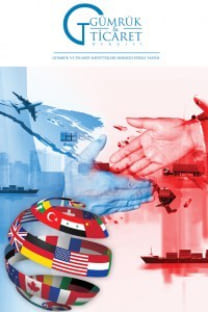Gümrük Risk Yönetiminde İleri Analitik Yaklaşımlar: Veri Madenciliği
Dünya ekonomisindeki serbestleşme ve küreselleşme eğilimleriyle birlikte ülkeler hem ticareti kolaylaştırıcı uygulamaları gündemlerine almakta, hem de arz zincirinin daha güvenli hale getirilebilmesi için çeşitli çalışmalar yürütmektedirler. Tüm bu gelişmeler gümrük idarelerinde risk yönetimi kavramının önemini artırmaktadır. Bu çalışmada, ileri analitik tekniklerinden biri olan veri madenciliğinin gümrük risk yönetiminde kullanımı incelenmiştir. Çalışma sonucunda, gümrük idarelerinde gelişmiş bir risk yönetimi sisteminin olmasının ve bu sistemin yeni nesil teknolojilerle desteklenmesinin sağlayacağı faydalar üzerinde durulmuştur.
Anahtar Kelimeler:
Risk Yönetimi, Veri Madenciliği, Gümrük
Advanced Analytics in Customs Risk Management: Data Mining
With the liberalization and globalization trends in the world economy, countries not only put trade facilitating practices on their agenda, but also carry out various studies to make the supply chain more secure. All these developments have increased the importance of risk management in customs administrations. In this study, the use of data mining, which is one of the advanced analytical techniques, in risk management is examined. As a result of the study, the benefits of having an advanced risk management system in customs administrations and supporting this system with new generation technologies are emphasized.
Keywords:
Risk Management, Data Mining, Customs,
___
- 1. Berry, M. ve Linoff, G. (1997), “Data Mining Techniques”, Indiana: John Willey & Sons Inc.
- 2. Chen, F., Deng, P., Wan, J., Zhang, D., Vasilakos, A. V. ve Rong, X. (2015), “Data Mining for the Internet of Things: Literature Review and Challenges”, International Journal of Distributed Sensor Networks, 11(8), http://doi. org/10.1155/2015/431047.
- 3. Committee for Economic and Commercial Cooperation of the Organization of the Islamic Cooperation. (COMCEC) (2018), “Facilitating Trade: Improving Customs Risk Management Systems in the OIC Member States”, Ankara.
- 4. Digiampietri, L. A., Roman, N. T., Meira, L. A., Filho, J. J., Ferreira, C. D., Kondo, A. A ve Goldenstein, S. (2008), “Uses of Artificial Intelligence in the Brazilian Customs Fraud Detection System”, In Proceedings of the 2008 International Conference on Digital Government Research (181-187).
- 5. DGÖ (1999), “Revize Kyoto Sözleşmesi”, Customs Co-operation Council, World Customs Organization, Brussels.
- 6. DGÖ (2011), “Customs Risk Management Compendium”, World Customs Organization, Brussels.
- 7. DGÖ (2015), “Küresel Ticaretin Güvenliği için Standartlar (SAFE) Çerçevesi”, World Customs Organization, Brussels.
- 8. DGÖ (2018), “Glossary of International Customs Terms”, World Customs Organization, Brussels.
- 9. DTÖ ve DGÖ (2022), “The Role of Advanced Technologies In Cross-Border Trade: A Customs Perspective”, London: World Trade Organization.
- 10. Gümrük Kanunu, 04/11/1999 tarihli 23866 Sayılı Resmi Gazete, Ankara.
- 11. Koç, Ö. (2016), “Yetkilendirilmiş Yükümlü Statüsünün Risk Yönetimi Açısından Değerlendirilmesi, Türkiye ve Avrupa Birliği Uygulamaları” (Yayımlanmamış Uzmanlık Tezi), T.C. Gümrük ve Ticaret Bakanlığı, Ankara.
- 12. Labare, M ve Migeotte, J. (2020), “Evaluating the Impact of Data Analytics on the Customs Risk Management Process: A Balancing Act” [PowerPoint slaytı], 15th Annual PICARD Conference, http://na.eventscloud.com/ ehome/picard2020/1096881, 25/08/2022.
- 13. Laporte, B. (2011), “Risk Management Systems: Using Data Mining In Developing Countries’ Customs Administrations”, World Customs Journal, 5(1), 17-27.
- Yayın Aralığı: Yılda 4 Sayı
- Başlangıç: 2013
- Yayıncı: Gümrük ve Ticaret Müfettişleri Derneği
Sayıdaki Diğer Makaleler
Gümrük Risk Yönetiminde İleri Analitik Yaklaşımlar: Veri Madenciliği
Türkiye’de Vergi İnceleme Sürecinde İncelenecek Mükelleflerin Tespiti
Endüstri 4.0 Sürecinin Beyaz Eşya Sektörü Üzerindeki Etkileri: Arçelik Örneği
5607 Sayılı Kaçakçılıkla Mücadele Kanunu Kapsamında Gümrük Kaçakçılığı Türleri
